I tried to make a dynamic 5x5 int array
int **data=malloc(5*5);
But I get segmentation fault on trying to access it.
I tried to make a dynamic 5x5 int array
int **data=malloc(5*5);
But I get segmentation fault on trying to access it.
You need to allocate memory for the 2d-array you want to make (which I think you understand). But first, you will have to allocate the space for pointers where you will store the rows of the 2D-array.
int **data=(int**)malloc(sizeof(*data)*5); //Here 5 is the number of rows
Now you can allocate space for each row.
for(int r=0;r<5;r++){
data[r]=(int*)malloc(sizeof(**data)*5);//here 5 is the width of the array
}
If you want contiguous block of memory for the whole array, you can allocate a single dimension array of size 25, and access it like data[r*5+c].
PS: Instead of sizeof(*data) and sizeof(**data), you can use sizeof(int*) and sizeof(int) to avoid confusion with *
PS: If you are not using C++, removing the casts from return value of malloc is better (see comments).
If you want a single contiguous memory block to hold 5x5=25 integers :
int *data = malloc(5*5*sizeof(*data));
If you want a 2d array with size 5x5
int **data = malloc(5*sizeof(*data));
for (int i=0; i<5; ++i)
data[i] = malloc(5*sizeof(**data));
There are two possibilities. The first one is indeed to allocate a two-dimensional array:
int ( *data )[5] = malloc( 5 * 5 * sizeof( int ) );
In this case one contiguous extent is allocated for the array.
The second one is to allocate at first a one-dimensional array of pointers and then allocate one-dimensional arrays pointed to by the already allocated pointers.
For example
int **data = malloc( 5 * sizeof( int * ) );
for ( size_t i = 0; i < 5; i++ )
{
data[i] = malloc( 5 * sizeof( int ) );
}
In this case there are allocated in fact 6 extents of memory: one for the array of the pointers and other 5 for arrays of integers.
To free the allocated memory in the first example it is enough to write
free( data );
and in the second example you need to write the following
for ( size_t i = 0; i < 5; i++ ) free( data[i] );
free( data );
If you want to treat the array as a 2D array (a[i][j]) and you want all the array elements to be contiguous in memory, do the following:
int (*data)[5] = malloc( sizeof *data * 5 );
If you also want to be table to determine the size of the array at run time and your compiler supports variable-length arrays1:
size_t rows, cols;
...
int (*data)[rows] = malloc( sizeof *data * cols );2
If your compiler does not support VLAs and you still want to determine the array size at runtime, you would do:
size_t rows, cols;
...
int **data = malloc( sizeof *data * rows );
if ( data )
{
for ( size_t i = 0; i < rows; i++ )
{
data[i] = malloc( sizeof *data[i] * cols );
}
}
The downside of this approach is that the rows of the array are not guaranteed to be contiguous in memory (they most likely won't be). Elements within a single row will be contiguous, but rows will not be contiguous with each other.
If you want to determine the array size at runtime and have all the array elements be contiguous in memory but your compiler does not support variable-length arrays, you would need to allocate a 1D array and manually compute your indices (a[i * rows + j]):
int *data = malloc( sizeof *data * rows * cols );
__STDC_NO_VLA__ should support VLAs.sizeof *data is well-defined in this example; the sizeof expression is normally evaluated at compile time, but when the operand is a VLA the expression is evaluated at run time. data doesn't point to anything yet, and attempting to dereference an invalid pointer leads to undefined behavior. All I can say is that I've used this idiom a lot and never had an issue, but that may be due more to bad luck than design.Here is the answer:
int ** squaredMatrix;
int szMatrix=10;
squaredMatrix= (int**)malloc(szMatrix*sizeof(int*));
for making 2d arrays you should view them as one array which every block is an array again .

for example in above picture , blue blocks make an array which each blue block is pointing to an array ( every 4 green blocks in a row are an array and blue blocks in a column are the main array)